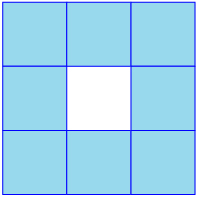Section 1
1. Section 1
1.5. Discover
Section 1: Viewing and Representing 3-D Objects
Discover
In this section you will investigate ways of looking at three-dimensional objects. For the first activity you will need some paper.
Try This 1
You will sketch all possible views of three-dimensional objects. These objects are composed of cubes and can be viewed using 3D Object Applet.
Follow the instructions to see the different views of the three-dimensional object:
- Use your mouse to rotate the object. Click on the object and then move the mouse in the direction of rotation.
- Use the arrow keys on your keyboard to rotate the object. The left and right arrows will turn the object horizontally. The up and down arrows will rotate the object vertically.
You should now be able to view the object from the sides, from the front and back, and from the top and bottom.
If you rotate this object, you can view the object directly from the front. You will see the following figure.

- Sketch and label this front view.
- Draw and label all the other possible views. To keep track, you may want to colour the squares to match the object in the applet.
- How many views are possible?
- Are all the views different? Why or why not?
- Use the applet to create a new three-dimensional object by following these instructions:
- Click on “Show All Cubes” to reset the cube.
- Select a view button under “Adjust Figure by Layers: Front - Back, Top - Bottom, or Left - Right.”
- Click on the coloured cubes to delete a cube.
- Click on the white cubes to add a cube.
- Draw and label all possible views for the new object. If you are working with a partner, challenge each other with more complicated objects.
- Did you notice any relationship between parallel views, such as top and bottom, front and back, or left and right? Are they always the same views, or can they be different?
![]() Save your sketches and responses to your course folder.
Save your sketches and responses to your course folder.
Share 1
Share your responses to the questions in Try This 1 with a classmate or with a group of people.
- To represent the 3-D objects in two dimensions, how many views are necessary? Does it depend on the object? Explain how you would choose the number of views needed.
- For question 6, what similarities and differences between the relationships were observed?
![]() If required, save a copy of your discussion in your course folder.
If required, save a copy of your discussion in your course folder.
